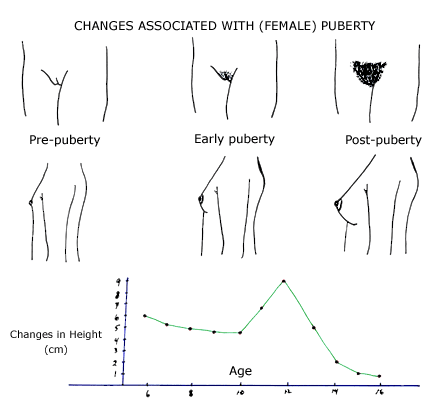| visit: www.infertilitytutorials.com |
|
A female enters the "reproductive years" at puberty. Puberty (female) can be "functionally defined" as a series of developmental changes that result in the ability to reproduce sexually (become pregnant). The single event that is most characteristic of female puberty is the onset of ovulation (release of "fertilization capable" eggs). Immediately following birth, a female’s reproductive system (hypothalamic-pituitary-ovarian axis) is fully functional. Shortly thereafter, this "system" is suppressed (shut down) and normally continues to be inoperative throughout most of childhood. At puberty, there is a restoration of activity in the reproductive axis and the female begins to ovulate. The physical changes that take place during the "pubertal years" are predominantly thought to be a result of shifts in the hormone concentrations that occur during this time period. As estrogen increases due to enhanced production by the ovary, (1) skeletal growth (the growth spurt) begins, which is subsequently accelerated by an increase in growth hormone (GH, due to elevated estrogen) and insulin like growth factor - 1 (IGF-1, due to increased GH); (2) breasts initially "bud" and then develop fully; and (3) vaginal and uterine growth takes place. Androgenic hormone concentrations also increase, predominantly through enhanced production by the adrenal glands, which then result in the growth of pubic and axillary (arm pit) hair. On occasion, a girl will undergo pubertal changes earlier than normal. If puberty occurs prior to 8 years of age in the USA (which is 2.5 (two and a half) standard deviations below the mean age of puberty within the United States) this is referred to as "precocious puberty." A medical evaluation of girls undergoing precocious puberty should be considered (is important) for a variety of reasons. Initially, medically harmful abnormalities leading to this condition should be excluded (or identified and treated as early as possible). Socially, these girls may be the subjects of abuse (either sexually by adults or socially by classmates) so that arresting (or minimizing) these physical changes is important when possible. Girls undergoing precocious puberty without treatment also initiate, undergo, and conclude their growth spurt at an early age, which initially results in them being the "tallest girl in the class" but ultimately results in (overall) stunted growth (very short adults). | |||||||||||||||

